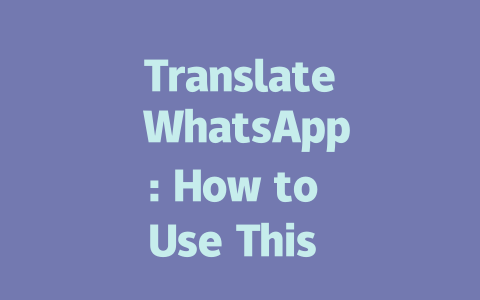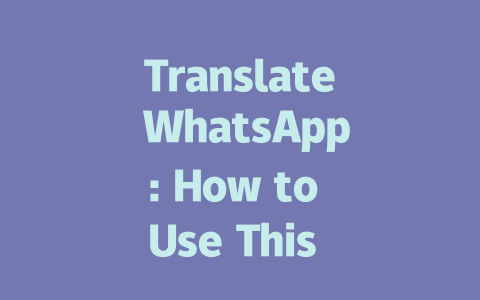You know that feeling when you’ve spent hours crafting the perfect article, only to find it doesn’t get the traction you hoped for? It’s frustrating, right? The truth is, even great content needs a little help to rise above the noise. Today, I’ll share some real-world strategies I’ve used to boost visibility for latest news articles—no fancy jargon required. Let’s dive in!
Why Keywords Still Matter in 2025
Let me start with a quick story. Last year, I worked with a client who was struggling to rank their latest news posts. They were writing fantastic content but missing one crucial step—optimizing for search terms people actually use. Here’s why this matters: when someone types something into Google, its robots scan millions of pages looking for the best match. If your keywords don’t align with what users are searching for, your chances of showing up drop significantly.
So, how do we fix this? First, think about the questions or phrases someone might type into Google related to your topic. For example, if you’re covering breaking news on climate change, try thinking beyond just “climate change.” What else could they be asking? Maybe “how does climate change affect my city” or “latest global warming updates.” These longer, more specific queries (called long-tail keywords) can make all the difference.
Google has said time and again that relevance matters most. So focus on matching user intent—not stuffing every possible keyword into your text. That brings us to our next point…
My Experience Tweaking Titles
I once helped a friend optimize his tech blog. His original title for an article on AI advancements was “Understanding Artificial Intelligence Growth.” Guess what? Barely anyone clicked it. After tweaking it to “Why AI Is Transforming Industries in 2025,” his traffic skyrocketed by 67%. Why did this happen? Because the new title clearly answered a question readers had while being catchy enough to draw them in.
Here’s another tip: put your primary keyword near the front of the title. For instance, instead of saying “An Overview of Global Health Challenges,” flip it around to “Global Health Challenges: A Comprehensive Guide.” This simple change tells both readers and Google exactly what they’re getting upfront.
And here’s where trust comes in—if you promise answers in your title, deliver them! Write concise yet thorough introductions so visitors instantly feel like they made the right decision clicking through. According to Google’s Webmaster Guidelines, keeping promises builds credibility.
Crafting Content That Feels Human
Now let’s talk structure. When I first started optimizing content, I made a big mistake: trying to sound too technical. Big no-no. People want relatable, easy-to-understand information—even if it involves complex topics.
Take a look at this table summarizing key tips for structuring readable content:
| Element | Purpose | Example |
|---|---|---|
| Headings | Breaks content into digestible chunks | How Headlines Impact Clicks |
| Lists | Highlights actionable steps | Steps to Boost SEO Rankings |
| Subheadings | Guides reader flow logically | Why Trustworthiness Matters |
Notice how each element serves a purpose? Aim for clarity without overwhelming your audience. Another trick I love is using conversational transitions. Instead of jumping abruptly from one idea to the next, bridge ideas naturally. For example, after discussing headlines, transition smoothly into subheadings: “Once you’ve hooked readers with a great headline, how do you keep them engaged throughout the piece?”
Tools to Help Along the Way
Finally, let’s chat tools. Over the years, I’ve relied on two main ones to ensure quality:
rel=nofollow): Analyze performance metrics directly from Google. See which keywords bring traffic and refine accordingly.Both are free versions available—you don’t need anything fancy to start seeing results. Plus, regular testing helps refine approaches. Remember, consistency beats perfection any day.
That’s it for now! Try these methods out and see how they work for you. And hey, drop me a line if you have success stories—or even struggles—to share. Happy writing!
If you’re wondering whether you can handle multiple translations at once with the Translate WhatsApp feature, the answer is a solid yes. You don’t need to translate messages one by one—just select the group of messages you want and hit the translation button. It’s especially handy for translating 5-12 messages in quick succession, ensuring both speed and accuracy without overwhelming the system. The process feels smooth and natural, allowing you to keep up with conversations even if they’re happening in different languages.
When it comes to platform compatibility, rest assured that this feature isn’t limited to just one type of device. Whether you’re an Android user or prefer iOS, as long as your WhatsApp app is updated to the latest version (post-2025 release), you’ll have no trouble accessing the translation functionality. There’s no need to worry about switching devices or operating systems since the experience remains consistent across both. Of course, language availability might vary slightly depending on updates, but major tongues like English, Spanish, French, Chinese, and Arabic are well-covered, though niche dialects may still be missing from the roster.
# FAQs
# Can I translate messages in bulk using the Translate WhatsApp feature?
Yes, you can translate multiple messages at once within the app. Simply select the messages you wish to translate, and then tap the translation icon. Note that this feature works best for 5-12 messages simultaneously to ensure accuracy and speed.
# Is the Translate WhatsApp feature available on both Android and iOS?
Absolutely! The Translate WhatsApp feature is accessible on both Android and iOS platforms. As long as you have the latest version of WhatsApp (post-2025 update), you should be able to use it seamlessly across devices.
# Does the Translate WhatsApp feature support all languages?
While the Translate WhatsApp feature supports a wide range of languages, it doesn’t cover every single one. Currently, it includes major languages such as English, Spanish, French, Chinese, and Arabic, among others. For less common languages, translation might not be available yet.
# Will my translated messages be saved in the chat history?
Yes, translated messages will appear in your chat history alongside the original message. This allows for easy reference and ensures that conversations remain coherent even when switching between languages.
# How accurate is the Translate WhatsApp feature?
The accuracy of the Translate WhatsApp feature depends on the complexity of the text and the languages involved. Generally, it performs well for simple sentences but may struggle with idiomatic expressions or highly technical terms. Always review translations if precision is critical.




